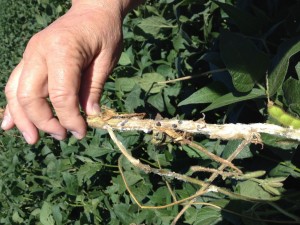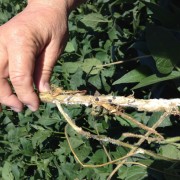Suppression of White Mold Where Gypsum Is Applied
 This past year White Mold was very prevalent in soybean fields across our area. Many producers are looking for management practices that will decrease the risk of having problems again this coming year. With any disease you must have the disease present, a host plant, and the right environment for the disease to survive. Since White Mold infects the plant at flowering, there is greater likelihood of having a favorable (warm moist) environment especially in heavy soils and narrow rows.
This past year White Mold was very prevalent in soybean fields across our area. Many producers are looking for management practices that will decrease the risk of having problems again this coming year. With any disease you must have the disease present, a host plant, and the right environment for the disease to survive. Since White Mold infects the plant at flowering, there is greater likelihood of having a favorable (warm moist) environment especially in heavy soils and narrow rows.
White Mold or Sclerotinia sclerotiorum attacks soybeans through flowers and small pods. It is known to produce oxalic acid which extracts calcium from the pectin that holds together cell walls. As a result, cell walls will collapse. It has been observed that gypsum will decrease the incidence of white mold. It is theorized that the gypsum increases calcium levels in the flowers and stems. This calcium reacts with the oxalic acid neutralizing it thus decreasing the spread of the disease through the plant.
We know that gypsum also helps increase infiltration and decrease standing water. This will decrease humidity somewhat within the growing crop, but more importantly decrease plant stress allowing for more defense of diseases. There has been less White Mold present where PRO CAL 40 has been applied.





